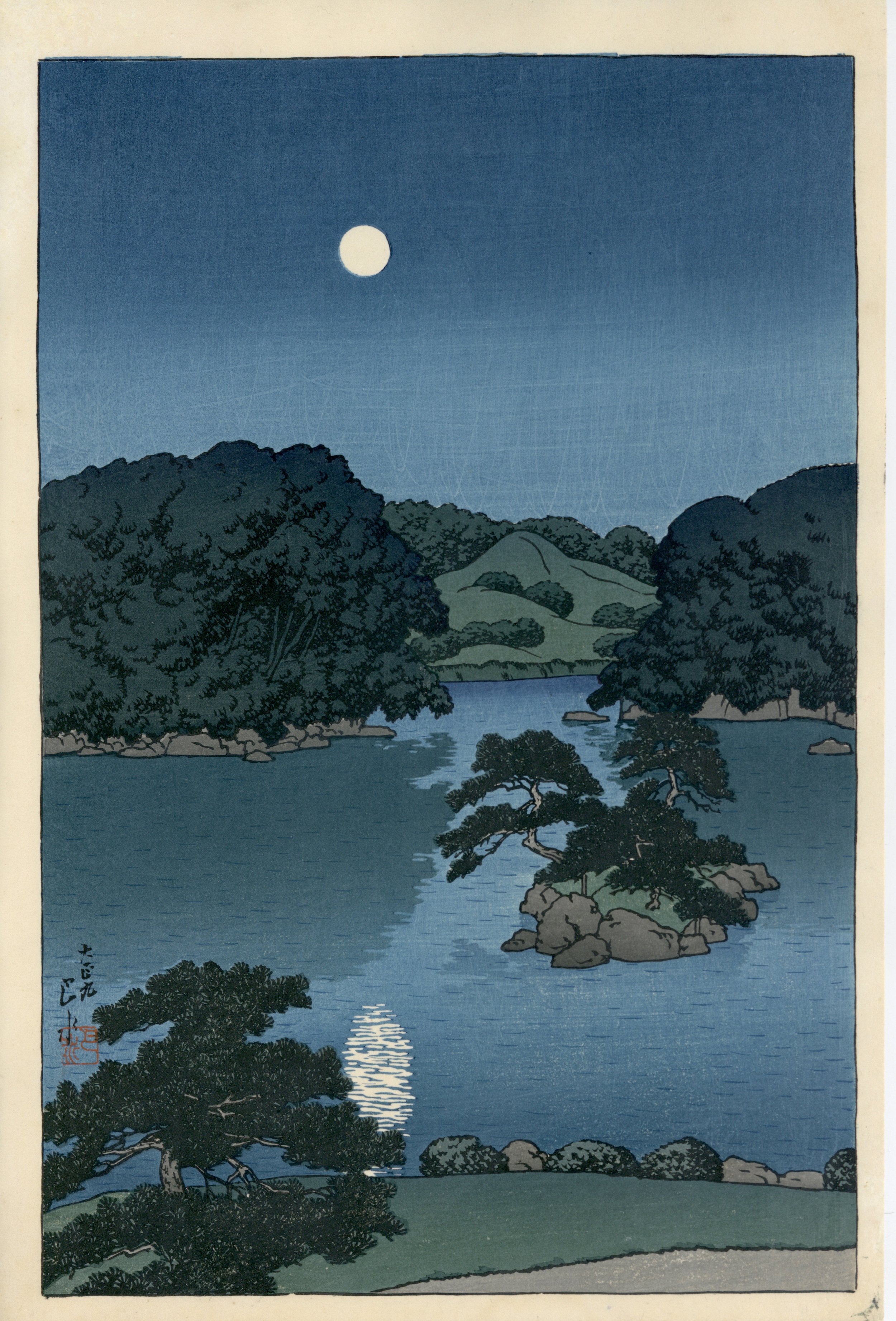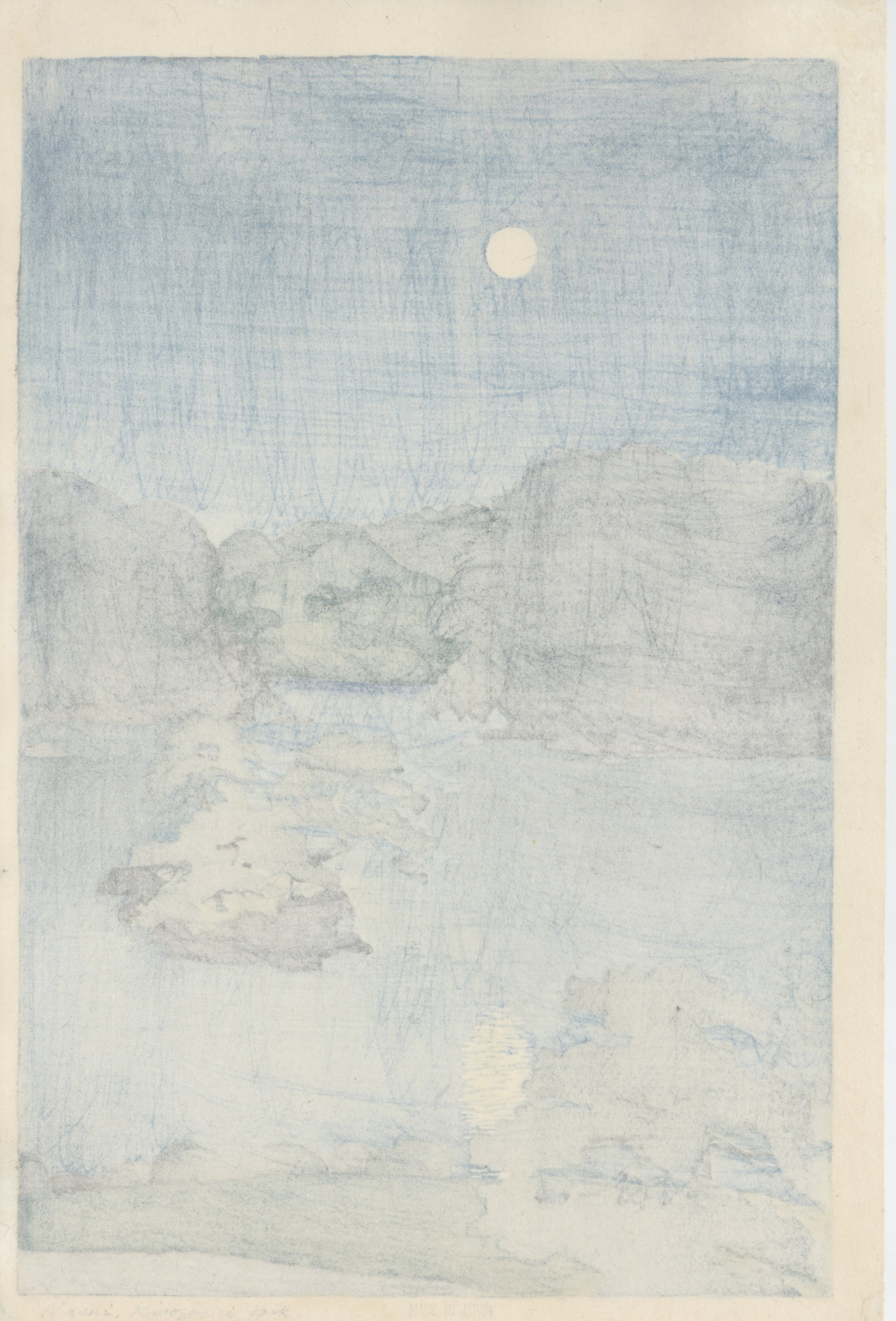Hasui | Moonlit Night , Daisensui Pond, Mitsubishi Villa at Fukagawa
川瀨巴水 Kawase Hasui ( 1883–1957)
三菱深川別邸图 月夜大泉水
Moonlit Night , Daisensui Pond, Mitsubishi Villa at Fukagawa
1920 (pre-earthquake)
木版画 | 纵绘大大判 | 38.8c m x 26 cm
Woodblock-print | Large Oban tate-e | 38.8c m x 26 cm
初摺且唯一版本;品相非常好
First and only one edition; great condition
SOLD
“我没有别的爱好,这(园林)是我唯一的兴趣所在。”——岩崎弥太郎
1878年,三菱商社创始人岩崎弥太郎正在筹建一座既能用于社员联谊,又可接待宾客的庭园。为此,他收购了一块位于今东京都江东区的荒废园地;两年之后,一座占地面积约10万平方米的庭园——深川亲睦园在此拔地而起。
885年,弥太郎去世,享年50岁。继任社长的胞弟弥之助开始了对庭园的进一步升级:他先是建起了作为别邸的洋馆和日本馆,而后又引入了隅田川的河水,将全园改造为了回游式的林泉庭园。
转眼到了1920年,受三菱商社之托,画家镝木清方接受了创作深川别邸主题版画的邀请,并举荐了弟子川濑巴水作为主笔。之后,不负众望的巴水很快便完成了一套优秀的八图连作。这套赠礼画不仅获得了三菱及欧美客商的一致好评,更为巴水在海外赢得了广泛盛誉。
明月夜,无风天。在园内东侧,被称为“大泉水”的池中,溶溶月光清凉,几处浮岛葱茏。其上白石若龟状,苍松似鹤形,掩映出后方一座宛如富士山的中岛。若是天气晴好,角度适当,你甚至也能在这儿一览“逆富士”的绝景。但面对如此良夜,最合适的还是于池边石子路漫步,伴着虫鸣,静静聆听耳畔阵阵的水声——那可是日夜不息的,来自隅田川的活水啊。
就在本作完成后的第三年,日本发生了关东大地震,园内的洋馆及日本馆皆因此毁于一旦。但由于池水与树木有效地遏制了火灾的蔓延,附近数以万计的居民得以逃出生天。
震后,三菱三代目社长久弥将受损较少的部分庭园捐赠给了东京市。经过几年的整修,1932年7月24日,“清澄庭园”正式面向公众开放。九十年光阴荏苒,至今,园内风景如画,秀丽依然。
Interested in purchasing?
Please contact us.
川瀨巴水 Kawase Hasui ( 1883–1957)
三菱深川別邸图 月夜大泉水
Moonlit Night , Daisensui Pond, Mitsubishi Villa at Fukagawa
1920 (pre-earthquake)
木版画 | 纵绘大大判 | 38.8c m x 26 cm
Woodblock-print | Large Oban tate-e | 38.8c m x 26 cm
初摺且唯一版本;品相非常好
First and only one edition; great condition
SOLD
“我没有别的爱好,这(园林)是我唯一的兴趣所在。”——岩崎弥太郎
1878年,三菱商社创始人岩崎弥太郎正在筹建一座既能用于社员联谊,又可接待宾客的庭园。为此,他收购了一块位于今东京都江东区的荒废园地;两年之后,一座占地面积约10万平方米的庭园——深川亲睦园在此拔地而起。
885年,弥太郎去世,享年50岁。继任社长的胞弟弥之助开始了对庭园的进一步升级:他先是建起了作为别邸的洋馆和日本馆,而后又引入了隅田川的河水,将全园改造为了回游式的林泉庭园。
转眼到了1920年,受三菱商社之托,画家镝木清方接受了创作深川别邸主题版画的邀请,并举荐了弟子川濑巴水作为主笔。之后,不负众望的巴水很快便完成了一套优秀的八图连作。这套赠礼画不仅获得了三菱及欧美客商的一致好评,更为巴水在海外赢得了广泛盛誉。
明月夜,无风天。在园内东侧,被称为“大泉水”的池中,溶溶月光清凉,几处浮岛葱茏。其上白石若龟状,苍松似鹤形,掩映出后方一座宛如富士山的中岛。若是天气晴好,角度适当,你甚至也能在这儿一览“逆富士”的绝景。但面对如此良夜,最合适的还是于池边石子路漫步,伴着虫鸣,静静聆听耳畔阵阵的水声——那可是日夜不息的,来自隅田川的活水啊。
就在本作完成后的第三年,日本发生了关东大地震,园内的洋馆及日本馆皆因此毁于一旦。但由于池水与树木有效地遏制了火灾的蔓延,附近数以万计的居民得以逃出生天。
震后,三菱三代目社长久弥将受损较少的部分庭园捐赠给了东京市。经过几年的整修,1932年7月24日,“清澄庭园”正式面向公众开放。九十年光阴荏苒,至今,园内风景如画,秀丽依然。
Interested in purchasing?
Please contact us.
川瀨巴水 Kawase Hasui ( 1883–1957)
三菱深川別邸图 月夜大泉水
Moonlit Night , Daisensui Pond, Mitsubishi Villa at Fukagawa
1920 (pre-earthquake)
木版画 | 纵绘大大判 | 38.8c m x 26 cm
Woodblock-print | Large Oban tate-e | 38.8c m x 26 cm
初摺且唯一版本;品相非常好
First and only one edition; great condition
SOLD
“我没有别的爱好,这(园林)是我唯一的兴趣所在。”——岩崎弥太郎
1878年,三菱商社创始人岩崎弥太郎正在筹建一座既能用于社员联谊,又可接待宾客的庭园。为此,他收购了一块位于今东京都江东区的荒废园地;两年之后,一座占地面积约10万平方米的庭园——深川亲睦园在此拔地而起。
885年,弥太郎去世,享年50岁。继任社长的胞弟弥之助开始了对庭园的进一步升级:他先是建起了作为别邸的洋馆和日本馆,而后又引入了隅田川的河水,将全园改造为了回游式的林泉庭园。
转眼到了1920年,受三菱商社之托,画家镝木清方接受了创作深川别邸主题版画的邀请,并举荐了弟子川濑巴水作为主笔。之后,不负众望的巴水很快便完成了一套优秀的八图连作。这套赠礼画不仅获得了三菱及欧美客商的一致好评,更为巴水在海外赢得了广泛盛誉。
明月夜,无风天。在园内东侧,被称为“大泉水”的池中,溶溶月光清凉,几处浮岛葱茏。其上白石若龟状,苍松似鹤形,掩映出后方一座宛如富士山的中岛。若是天气晴好,角度适当,你甚至也能在这儿一览“逆富士”的绝景。但面对如此良夜,最合适的还是于池边石子路漫步,伴着虫鸣,静静聆听耳畔阵阵的水声——那可是日夜不息的,来自隅田川的活水啊。
就在本作完成后的第三年,日本发生了关东大地震,园内的洋馆及日本馆皆因此毁于一旦。但由于池水与树木有效地遏制了火灾的蔓延,附近数以万计的居民得以逃出生天。
震后,三菱三代目社长久弥将受损较少的部分庭园捐赠给了东京市。经过几年的整修,1932年7月24日,“清澄庭园”正式面向公众开放。九十年光阴荏苒,至今,园内风景如画,秀丽依然。
Interested in purchasing?
Please contact us.
Kawase Hasui (1883–1957)
Kawase Hasui is perhaps the single most recognized woodblock artist of the Shin Hanga – new print – movement in the early- to mid-20th Century. Because he specialized in landscapes, many would say he was a successor to Hiroshige, noting his enveloping portrayals of nature, and his thoughtful placement of humans within them. But that would be too easy, because Hiroshige and Hasui in many ways could not be more different.
Whereas Hiroshige played with flat plains of negative space, Hasui embraced Western painting styles – if not techniques – to display water reflections, shadows and shades of light in all its combinations. You can easily discern the time of day and season from the light. Signs of the 20th Century Japan are everywhere – rickshaws, cars, telephone poles, steamships, even western-style umbrellas and rain slickers. Yes, he embraced snow and rain scenes like Hiroshige, and many famous views, but they live in a three-dimensional, modern world.
His prints are hugely sought-after today, with condition being extremely important to collectors. Many of the original woodblocks were destroyed in the Great Earthquake of 1923; finding examples of those pre-quake prints is challenging, indeed.
He was born Bunjiro Kawase in Tokyo in 1883, the son of a merchant. Hasui studied Japanese-style painting with Kiyokata and Western painting at the Hakubakai. He exhibited his first painting at 19. The publisher Shozaburo Watanabe – seeing the appeal of woodblock prints to the Western tourists then flooding Japan – took Hasui under his wing. The young man travelled widely to capture landscapes, making sketches as he went. Looking at the detail and perspective in some of his prints, one wonders: did he work from photographs as well?
Hasui’s Zojoji Temple in Snow – with a purple kimono-clad woman pushing against the furious snow with a traditional umbrella -- has been named an Intangible Cultural Treasure, the greatest artistic honor in postwar Japan. He died in 1957.
The publishers Doi, Kawaguchi, Sakai and others also produced some Hasui works. Learning to read the seals on the prints, and therefore dating them, takes time but is well worth it. If you can find this book at a reasonable price, go for it. It’s all there.


